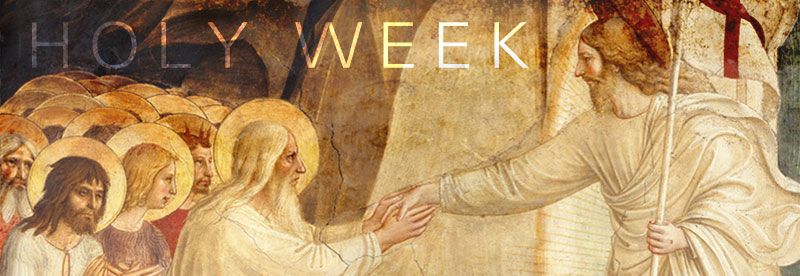— Click here for Times and Locations for Holy Week —
—- • —-
Descending with Jesus into the remembrance of his passion past, I look ahead to the shadow hope of resurrection cresting near, beneath any crosses I bear.
Explanations and justifications all pale to the color of pain I see among humankind. Strangely, I am comforted seeing that Christ’s resurrection light also contains all the hues of the human condition, including the color of our tears, violence, and suffering.
– Peter Traben Haas
—- • —-
Palm Sunday, April 13
Readings: Matthew 21:1-11; Philippians 2:5-11; Matthew 27:1-54
Begin with the above centering prayer, by Peter Traben Haas, as you reflectively read today’s Scriptures.
As pilgrims swelled the population of Jerusalem, anticipating the annual Festival of Unleavened Bread that began with Passover, Jesus rode into the city of his ancestor King David. But instead of a general’s war horse, he rode in on a donkey—the symbol of humility and peace (Zechariah 9:9). The pilgrims who were singing Psalms (such as 118:25-26) began laying down their cloaks in his path (symbolizing submission to a king) and waving the palm branches of peace as they cried “Hosanna”—“Help! Save!” Some in this same crowd will shout “Crucify him!” by the end of the week. And so, we begin our Palm Sunday celebration praising this King of Peace, while being aware that in some ways we too are like the fickle crowd.
—- • —-
Maundy Thursday, April 17
Reading: John 13:1-17, 31-35
Begin with the above centering prayer, by Peter Traben Haas, as you reflectively read today’s Scriptures.
The word maundy comes from the Latin mandautum or “commandment,” referring to the new commandment Jesus gave his disciples in the upper room—to love one another as he had loved them (John 13:34). When he knew that he had all authority he washed their feet (John 13:3-5). Then Jesus celebrated the Jewish Passover in a way that made the bread and wine our Christian Passover, the sign of the new covenant established through his death and resurrection. As we recall the “night when he was betrayed” (1 Cor. 11:23) the liturgy asks us to see our own sin as the betrayal of Christ—to come to the table no better than Judas with whom Jesus shared bread. When we eat the bread and take the cup we are saying: Jesus’ death was for me. I accept the fact that I am now reconciled through the sacrifice of Jesus. On this night we come face to face with the fact that our peace with God does not come through our moral goodness, but only through Jesus’ death. At the end of the service the altar is stripped, symbolizing the stripping of Jesus’ garments for his crucifixion. All signs of life and color are taken away.
—- • —-
Good Friday, April 18
Readings: Isaiah 52:13 – 53:12; Psalm 22:1-11; Hebrews 4:14-16; 5:7-9; John 19:1-37
Begin with the above centering prayer, by Peter Traben Haas, as you reflectively read today’s Scriptures.
On this day we are witnesses of the crucifixion of Jesus. It is “Good Friday” because on this day the powers of evil were dethroned by the one whose life could not be taken, but who gave his life that we might have life. It is a day of mixed emotions: sorrow because we identify with his suffering; joy because we know that his death is our salvation. As we contemplate the Way of the Cross—Jesus being condemned to death, nailed to the cross, and placed in the grave, we experience our sins being placed upon him, nailed to his cross, and buried with him in the grave.
—- • —-
Holy Saturday, April 19
Readings: John 19:38-42; Galatians 5:1; 2 Corinthians 6:11-13; Matthew 16:18
Begin with the above centering prayer, by Peter Traben Haas, as you reflectively read today’s Scriptures.
Most have an awareness of Good Friday and everyone knows about Easter. But what happened between those two days? How does the church celebrate that? What is holy about Holy Saturday? Holy Saturday is the day that spiritually unifies and stitches together the cross and resurrection. Christians have always set aside this day for prayer and meditation. The public service of the church is very simple and stripped-down to a few readings and prayers. We contemplate both the Passion of Christ and the reaction of his first friends. How might they have felt to see their dreams crushed by his brutal death on the cross? As you imaginatively enter into this scene of dark despair, bring to God any remaining darkness you discovered in Lent. As you do, receive the awareness that, like Jesus in the dark tomb, you too are held in the Father’s love—our Father who is already always there.
—- • —-
Easter Sunday, April 20
Readings: Acts 10:34-43; Matthew 28:1-10
Christ is risen! Christ is risen, indeed!
Do not abandon yourselves to despair. We are the Easter people and hallelujah is our song. ― Pope John Paul II
Easter changes everything! Why? Christians are in Christ. What is true of him will be true of us. On Easter we affirm not merely, Christ is risen, but I shall rise. This is the confidence that fuels martyrs. It is the poise that allows an exhausted mom to get the last child in bed with kindness and love. Easter provides the certainty that allows those who find life challenging to keep walking in faith while they wait for a spouse to marry, a new job, to finish that last class before graduation, or to anticipate a friendship to be reconciled. Easter-faith is both backbone and joy for the journey—it changes everything!

